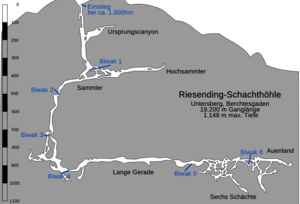Riesending cave

The Riesending cave (German: Riesending-Schachthöhle) is a pit cave in Untersberg and the deepest and longest in Germany. It was discovered in 1996. In June 2014 it became well known because of a large effort to rescue a lead speleologist.
Description
The Riesending cave (German for "huge thing") is a pit cave in Untersberg, Bavaria. At 19,300m it is the longest and 1,148m the deepest in Germany.[1] Riesending was discovered in 1996 by Hermann Sommer and Ulrich Meyer.[2]
In June 2014 Riesending became well known to the general public for the largest ever rescue effort, the Rescue in the Riesending cave, taking eleven days by 700 members of a multinational group of cave rescuers to rescue 52-year-old Johann Westhauser, one of the original and principal researchers of the cave, a physicist, speleologist and cave rescuer himself, who had been injured in a rockfall deep in the cave .[3]
See also
Further reading
- Thomas Matthalm, Ulrich Meyer (2009). "Die Riesending-Schachthöhle im Untersberg" (PDF). Die Höhle – Zeitschrift für Karst und Höhlenkunde. Verband Österreichischer Höhlenforscher, Verband der deutschen Höhlen- und Karstforscher e.V. 60: 33–43.
- Lars Abromeit (2010). "An diesen geschundenen Strick soll ich mein Leben hängen?" (1). GEO: 100–114.
- Ulrich Meyer, Thomas Matthalm (2011). "Die Riesending-Schachthöhle im Untersberg" (PDF). Mitteilungen des Verbands der Deutschen Höhlen- und Karstforscher e.V. München. 57 (2): 36–44. ISSN 0505-2211. Retrieved 2012-10-25.
- Ulrich Meyer (2012). "Auf der Suche nach dem Barbarossa-System im Untersberg" (PDF). Akten des 13. Nationalen Kongresses für Höhlenforschung, 2012 – Actes du 13e Congrès national de Spéléologie. Muotathal: 68–74. Retrieved 2012-10-25.
- Ulrich Meyer: Das Riesending im Untersberg. Arbeitsgemeinschaft für Höhlenforschung Bad Cannstatt e.V. (Hrsg.), Bad Cannstatt 2015.
References
| Wikimedia Commons has media related to Riesending cave. |
- ↑ Thilo Müller und Andreas Krauf (n.d.). "Die längsten Höhlen". Verband der deutschen Höhlen- und Karstforscher.
- ↑ Stephanie Geiger (21 September 2008). "Bayerns tiefster Punkt". Die Welt.
- ↑ "Riesending rescue: German caver Johann Westhauser surfaces". BBC. Retrieved 19 June 2014. (NB. The article incorrectly states that the cave was discovered in 1995 by Johann Westhauser himself, however, the cave was discovered in 1996 by Hermann Sommer and Ulrich Meyer, but first explored by a team including Johann Westhauser in 2002.)
External links
| Wikimedia Commons has media related to Riesending cave. |
- Beschreibung der Riesending Höhle Website der Arbeitsgemeinschaft für Höhlenforschung Bad Cannstatt e.V.
- Stephanie Geiger „Bayerns tiefster Punkt“ in Die Welt, 21. September 2008